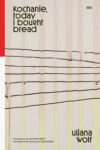
This essay was first made available last month, exclusively for our Interviewer and above level Patreon supporters. If you want to support Full Stop’s original literary criticism, please consider becoming a Patreon supporter.
After heavy rains eroded the ditch bank close to Bingham Hill cemetery and turned up the rotting casket of John Thomas, died 1877, the Rainbow Riders 4-H club took it upon themselves to do a service for the dead and move the grave. Storm-softened clay gave way easily. So did the coffin’s sponge-wood. In life, John Thomas had bright red hair, which still clung in tufts to the fragments of his skull, which lay on a sheaf of green pamphlets advertising tea. The deteriorating grave proved too difficult to move, so the 4-H club-members elected to reinter the body, wool socks still clinging to its foot-bones. They included in the coffin a note of apology. In 1989, an aspiring Eagle Scout rebuilt the ditch bank with railroad ties, and sealed John Thomas back into the hillside.
On visiting Rose at her ranch in LaPorte, Colorado, she offers to show me a shoebox with some of John Thomas’s red hair in it. She tells me that in all her time researching and caring for and living next to the small pioneer cemetery, which came with the land her husband bought to keep cattle in the seventies, Thomas’s body was the only one whose bones she had held, whose hair she had touched.
Rose grew up in Nebraska, and intends to be buried there when she dies. But she has spent much of her adult life in Colorado tracking down and identifying the bodies of strangers buried on her property. She has written and self-published a history of the cemetery, which takes up 1.2 acres. You can see it at a distance from her kitchen window.
When I ask about her motivation in carrying on such morbid volunteer labor, she insists she’s not a “cemetery nut.” She doesn’t “drive around the country looking for cemeteries.” Instead, “it just happened that the timing was right,” she tells me. “The placing was right. It was right here.”
Until this morning, Rose was a stranger with whom I’d only exchanged a few emails to coordinate a meeting so we could talk about the cemetery and her book. Now, at her dining room table, while her adult son surfs the internet in the living room beside a hot wood-stove, she shows me a photo of her priest standing on a glacier in Iceland. She also shows me a photo of a pipeline being dug on her property, and complains about the frackers in Greeley buying river-water to mix with proppants and shoot at high speeds deep into drill-holes.
In truth, I made up a reason to be here. I told Rose, a woman nearing eighty, that I wanted to interview her for my Master’s thesis research. I guess this is partly true, in the sense that “research” for an MFA in poetry is an all-encompassing thing, and you can count drinking with friends in a bar until closing on a Tuesday night as readily as you can reading for broken sonnets in the blank verse landscape of Paradise Lost.
I realize half-way through the conversation that the question I have come to ask has to do with allochthony, the opposite of autochthony, the latter meaning born from the earth, when a person springs local from the dirt. Demographically, an allochthon refers to one who “emerges from another soil.” Geographically, an allochthon is a landform displaced from its original position by a low angle thrust fault. Some of the foothills behind Rose’s property, pitched toward the sky at a shorn angle, have been thrust up and broken off by similar drifting pressures. I think my question for this keeper of pioneer dead is less about what it means to dwell in, and more what it means to care for a place where you didn’t choose to be, or where you could never have foreseen being.
From Rose I want to know: how do you take as yours what has been given? Maybe your husband is a beef cattle geneticist at the agricultural college, and the parcel of grange-land he purchases to study livestock has perched upon on it, not far from the house where you raise your seven kids, a little plot of illegible headstones.
A drill-rig in the pasture. The intaglio of ditches in the valley. The person you sleep beside in bed. A life is a kind of dirt. You are supposed to feel autochthonous to it, as if you belonged to it. You don’t have to think to take it for granted.
Later, when I move from Colorado to North Carolina to do a PhD in nineteenth-century American poetry, I start looking for gaps in the woodwork, fault-lines for fitting in. Parts of the intarsia I can loosen, slip between. But maybe a fit is not exactly what I’m after. What I’m looking for is a pattern, an infrastructure. Groundwork for a network for thought at speeds. In a new state, a new field for study, I want to move effortlessly, connectedly, as if to move was to more belong.
Passing clear-cut corridors for vaulting power-lines. Or on interstates and highways: pivoting through dense green walls of mixed deciduous and pine. I try to triangulate myself in a flattened landscape of strip mall, chapel, auto shop, tracking with the mills at intervals along the rivers that run tribute to Cape Fear. The Deep. The Haw. Mermaid Point, where they meet. To secure the network, I take walks through the North Forest near campus, listening to old oral history interviews with now-dead mill-workers that stream from the air to my iPhone. The dead tell me how if you worked in a spinning room you soon learned to read lips above the racket.
On the website Find a Grave, I learn some of the bodies of the voices in my ears are buried at a drivable distance. On a winter Saturday, I visit Burlington Memorial Gardens, seeking the graves of Henry A, Betty D. I listen to their interviews as I search. The grounds are larger than I thought they would be, and the office is closed, so I wander directionless and unrewarded between the headstones, gathering as a form of consolation sun-paled, mower-shredded fragments of false flowers, which I save in my coat pocket, as if I had some future purpose for them.

Over the next two years, I find my efforts as a scholar are met with similar results. A pocketful of plastic pansies gathered from the grounds of a burial garden whose dirt conceals the bodies of strangers. The feeling of trying too hard to belong. Not sure what I’m searching for, I start to drift in my studies toward the twentieth century, as near to the threshold of Pound and Eliot as I can come without crossing over into modernism, dwelling instead on a narrow range of years at the nineteenth century’s end in which books of poetry bore titles like “Thoughts,” “Dewdrops,” “Scribbles,” “Trifles,” “Daisies,” “Violets,” “Driftwood.”
One critic describes the American poets of the 1890s archly as the “Household Furniture School.” Theirs, the critic jokes, is the “poetry inherent in kitchen floors, kettles, clocks, rocking chairs, baby chairs, chimneys, cribs (trundle beds), cots, spinning wheels, and bureau drawers…[S]uch minutiae as old straw hats, shotguns, cigars, canteens, pipes, shoes, umbrellas, cucumber vines, beans, and even ‘my last tooth.’” Surrounded by the ephemeral, substanceless, and commonplace, I find myself less in a field of viable study as much as in the midst of a yard sale or a rural midden, the contents of a household turned out on a weedy lawn, left to gather dewdrops overnight.
But whether it was written in 1890 or 1809, it’s hard to know how to read a nineteenth-century American poem, setting the avant-gardism of Whitman and Dickinson aside. Many of the century’s best or most popular poems feel kindred to crochet, or lacy open-work. Their patterns are floral and ornate, but conventional. They are craft objects, piously scintillant, circulating in the margins of newspapers, sentimental column filler for prose-focused periodicals. Ornaments for the off-hours. Small balm. “Wildflowers gathered for a Sick Friend.” “The Sinless Child.” “Death of an Infant.”
For her own dissertation, my advisor wrote about three obscure nineteenth-century poetesses and their relationship to Edgar Allan Poe: Frances Sargent Osgood, Sarah Helen Whitman, and Elizabeth Oakes Smith. She later published the project as a well-regarded book. However, as she once confessed to me, there was a time she wondered if so many years of intellectual labor on Osgood, Whitman, and Smith—writers essentially unknown to contemporary audiences—was equivalent “to aiming a cannon at a gnat.”
Even as he was dying of consumption, Henry David Thoreau still stopped to study the growth patterns of ruderal weeds along the sand-banks of the railway that passed through his woods. Ruderal: growing where the earth has been disturbed, displaced, laid waste, opened to infrastructure.
The forgotten lots, margins, medians, and waste-lands of the nineteenth-century poem. Digging in that dirt in an attempt to lay a route. Some way to be in them, by moving through them. Weeds are the result.
But from the rock, rough-grained, and icy-crowned, / Some little flower from out some cleft will rise; / And in this quiet land my love I found, / With all their soft light, sleepy, in her eyes. // No bush to lure a bird to sing to her—/ In depths of calm the gnats’ faint hum was drowned, / And the wind’s voice was like a little stir / Of the uneasy silence, not like sound.
In November 1844, Edgar Allan Poe published in the United States Magazine and Democratic Review a selection of jotted notes penciled in the margins of books pulled at random from the shelves of his personal library.
In the margins beside a sentence in a treatise on conic sections by Apollonius of Perga (“The right angle of light’s incidence produces a sound upon one of the Egyptian pyramids”), Poe wrote:
It is nonsense, I suppose, — but it will not do to speak hastily. The orange ray of the spectrum and the buzz of the gnat (which never rises above the second A), affect me with nearly similar sensations. In hearing the gnat, I perceive the color. In perceiving the color, I seem to hear the gnat.
To study gnats and hear a pyramid, slanted orange in the declining sun.
In the scrutinized buzz, a far-flung association. A cryptic monolith where before there was only an irritation at the ear.
Digging near the pyramid of Amenemhat III at Hawara, the British archeologist Flinders Petrie uncovered the mortuary labyrinth that Herodotus described: twelve covered courts, each containing three thousand rooms, half above ground, half below. Those below include “the tombs of the kings who built the labyrinth, and also the tombs of the sacred crocodiles”; the upper rooms of carved marble are, according to the ancient historian, “an endless wonder,” full of “baffling and intricate passages from room to room and from court to court.”
In the vicinity, Petrie also exhumed burial pits filled with the mummies of professional upper-class Greek-Egyptians. Many of the bodies were accompanied by vivid portraits painted in beeswax on panels of linden wood, depicting the faces of the dead, who, while still living, commissioned these likenesses to distinguish them in death. Petrie found that he could revitalize the colors—gold, black, red, two different ochres—by carefully heating the wax. Exposed to candle-warmth, faces flushed back to life, returning to that day they sat to have their portrait taken, gazing at the painter as one might gaze at death, hands clasped in their laps, feeling their own cool body heat.
Petrie is known for formalizing the archeological technique of seriation: dating the layers of a dig-site based on fragments of upturned pottery. He remarked, “I believe the true line of research lies in the noting and comparison of the smallest details.” As an eight-year-old, he overheard some family friends describing the recent frenzied excavation of the Brading Roman Villa, some of its mosaics found while a farmer was laying the foundations for his sheep-pens on the Isle of Wight. Preternaturally appalled by the careless treatment of the site, the boy “protested that the earth should be pared away, inch by inch, to see all that was in it and how it lay.”
Along with the Labyrinth and the Fayum Portraits, Petrie also found at Hawara the unmarked, unadorned mummy of a young woman, her skull lying, like John Thomas’s on the pile of ads for tea, against a crumbling scroll that contained within it a copy of the second book of Homer’s Iliad—the great gathering of armies, the catalogue of ships.
Near the beginning of Book Two, before the catalogue, Agamemnon tarries in a rare moment of self-reflective clarity, aware of his immoderate ambitions, and of his own defenselessness to willful gods:
…but the son of Kronos / Zeus who bears the aegis, has rather brought me sorrows, / tossing me into insoluble quarrels and disputes. / For I and Achilles fought each other over a girl, / exchanging violent words, and my anger it was began it. / But if ever we reach agreement, from then no longer / shall the Trojans’ doom be postponed, not for a moment!
Despite his better angels, the king’s lack of temperance prevailed, poor in that virtue the ancient Greeks called sophrosyne. So Agamemnon marshaled his men and did what he could with the information he had, slaughtering a five-year-old ox in the name of Zeus, to whom the offering meant nothing. It was this same god after all who tricked the Argive king into hastening this great gathering of armies, sending them to their collective doom. Yet divine intervention only worked in tandem with a deeper flaw, an irritable, grasping impulse to possess, the vast resources of a foreign kingdom mustered in pursuit of a substanceless dream. Cannons aimed at gnats, their thin, hallucinated song.
The ancient Greek poet Simonides was born on the island of Keos, which afforded a level of isolation from the wars and political turmoil that gripped the mainland. Due to island’s isolated lay, the air enjoyed a high degree of what one nineteenth-century classicist described as “moral purity” (absent as it was of “courtesan and flute-girl”) and so Simonides was known to some for his sophrosyne, his perfect poise. A well-balanced life, gifted from the soil and the atmosphere. Yet the trouble with moral purity is that it produces “excessive longevity and consequent overpopulation”—and so at a certain age the inhabitants of Keos, unlike those belonging to other Greek states, who “relieved their congestion by the colonial route,” chose to follow “what we may call the hemlock route.”
Dan, an old teacher of mine, now a close friend, has recently finished translating from ancient Greek six lyric poets, including Simonides. One fragment addresses the difficulty of maintaining, especially when making things, the virtue of balance or sophrosyne: “Difficult to build by hand a man / truly good and well-built and with a mind, / four-square and made without a flaw…” Building, as it turns out, has nothing to do with it: “Good luck lets any man be good, / But luck is bad, the man is bad.” Simonides was autochthonous, native to good earth, and so he, too, was good. His goodness leads him to the following conviction: “And so I don’t waste my strength / to seek in hollow things meaning, I don’t / throw my life away on impossible hopes—/…I applaud and love any man / who knowingly shuts himself away / and does nothing shameful.”
Together walking the converted, now-verdant rail spur of the High Line in New York, on the lookout for a bite to eat and a drink, I confess to Dan that I have found it is hard to love the best-loved poems of the nineteenth century. With their too-simple clarity, they often resist my desire to read them deeply, and find in them some thought that re-surfaces the world around me, its landscape newly shifted, split. Unlike poems that promise what Rimbaud called a derangement of the senses, their lack of complication makes them somehow indistinct, ungraspable, non-adhesive—less-than-gossamer structures. I hold hungrily to the littlest kink or swerve in the language. To Dan I describe the process of looking for something to love in them as a kind of askesis, an exhausting practice. Sounding for light-strung pyramids in the barest buzzing octave of a gnat.
And I confess that the decision to work in this field, in this nineteenth-century dirt, was never something to which I gave much thought. Instead, in the care of certain teachers, it just happened that the timing was right. The placing was right. It was right here. Over time, I found myself laboring in a foreign land, whose virtues were not mine, not having sprung from its earth.
Lizette Woodworth Reese, an all-but-forgotten poet and school-teacher from Baltimore, Maryland, where Edgar Allan Poe is buried, helped bridge the transition from the nineteenth-century’s violets tied with string and pansies to modernism’s harsh, hard-cut images, its “spice-rose / drip[ping] such acrid fragrance / hardened in a leaf,” as H.D. puts it, for instance. One scholar has celebrated both Reese’s “exquisite simplicity” and her sophrosyne, describing her “ability, despite the genius which set her apart, to fit in with all phases of life. She made adjustments so well that more than once she was called ‘unimpressing.’”
Less a life than a series of adaptions and adjustments, a well-balancing.
She saw a garden as a place of law, of “fixity,” and the “sureness of things”: “A snowdrop is always white, and forever holds that green tip on the edge; a jonquil always cupped in gold. This is the law of the place. You are struck a hard blow; perhaps it is the breaking into pieces of an old dream, or the death of a friend, or the treachery of one whom you trusted as you trusted yourself. At first the world staggers under you, [as] you try to settle yourself into the hard and bitter new order of things. And yet everything in the garden goes on as before. Even the dry sound of a seedpod cracking open—as tiny a business as that —remains. This changelessness at first is one of the most bewildering of human experience…But—after a while it is this very changelessness which works your cure. To look out and see that unquenched blaze of scarlet geraniums in a corner of your garden is to see a candle to light you on your way. A sense of the continuity of life, the keeping on of affairs, of the certain security of the incomings and outwanderings of nature comes to you. Here is a staff to lean upon, a crook to clutch. Here are the everlasting arms.”
The snowdrop, daisy, and violet: timeless in their vibrancy, changeless in their plasticity. Perhaps the law of the garden holds as true for a handful of plastic flowers culled from the cut lawn of strange graves. Or for the tiny business of dewdrops and driftwood. Of lacework and gnats. Perhaps these, too, can help you settle yourself. To come to rest in the midst of green tips and permanent gold cups thrusting up from a restless earth.
In 1891, as Flinders Petrie was excavating the Great Temple of Aten on the banks of the Nile, Reese published a poem called “Love, Weeping, Laid this Song” in her book A Handful of Lavender. The poem bears a subtitle: “On a copy of the Iliad found with the mummy of a young girl.” The rest reads as follows, here in its entirety:
Lo! an old song, yellow with centuries!
She, she who with her young dust kept it sweet;
She, in some green court on a carved seat,
Read it at dusk fair-paged upon her knees;
And, looking up, saw there, beyond the trees
Tall Helen through the darkling shadows fleet;
And heard, out in the fading river-street,
The roar of battle like the roar of seas.
Love, weeping, laid this song when she was dead
In that sealed chamber, strange with nard and musk.
Outliving Egypt, see it here at last.
We touch its leaves: back rush the seasons sped;
For us, as once for her, in that old dusk,
Troy trembles like a reed before the blast!
It is Reese’s reconstruction of the dead girl’s distant imagination that revitalizes the Iliad’s yellow song. We re-read Agamemnon’s false dream by the dim light of the girl’s eyes, brightened back into living color by the candle-warmth of Reese’s poem. For us, as once for her: what Homer saw. From out of the substanceless terrain of a late century, I lend a hand at excavating Reese, who helps excavate a little reader, who in turn unburies for us Helen from the shade-trees. Mind spading into mind spading into mind. A daisy-chain of digging, but not, it must be said, in dirt. To read, not by light, nor any vision of my own, but a vision seen through the trees, a luminous dusk-dream. The pages brightened by being buried underneath the head of a nameless girl, Greek, allochthonous, entombed in Egypt—and then exhumed, decrypted.
For his part, blind Homer died undone, benighted, unable to solve a too-simple riddle posed to him by some fisher-boys by the sea-shore: “We left whatever we caught and carry whatever we didn’t.” It wasn’t fish they meant.
Nor a pocketful of false flowers, deathless plastic-polyester petals.
Trying to hear pyramids where there are only gnats.
For the answer to the riddle after all was lice. Something small as that.
Not knowing it was a simple louse he combed his brain for, as one might red hair, Homer perished of despair.
Kylan Rice has writing published in Denver Quarterly, Kenyon Review Online, Seattle Review, West Branch, and elsewhere. He is the editor-in-chief for The Carolina Quarterly. He is pursuing a PhD in literature at the University of North Carolina at Chapel Hill and holds an MFA in creative writing from Colorado State University.
This post may contain affiliate links.







